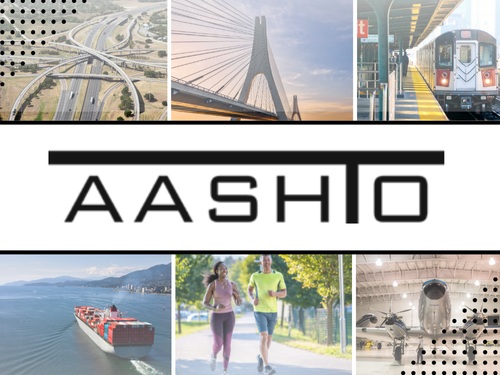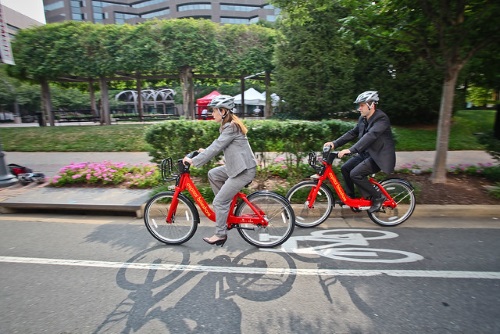A new report from the Rails-to-Trails Conservancy projects that shifting short trips from driving to walking and biking via connected active-transportation infrastructure could help generate a return on investment of $73 billion to $138 billion per year in the United States if connected to public transit systems.
[Above photo by the District of Columbia Department of Transportation.]
“More than half of all trips in the United States are within a 20-minute bike ride or less, and more than one in four trips are within a 20-minute walk or less, according to the 2017 National Household Travel Survey,” Rails-to-Trails said in its 62-page report. “Even so, the majority of these short trips are taken by automobile.”

The organization went on to argue in a statement that shifting short car trips in both urban and rural areas to non-motorized ones “will take policy, behavior and perception change, which can only occur if connected networks of safe and protected walking and bicycling facilities are built all across the nation.”
A key factor in its savings calculation argument is building more “synergy” between active transportation and public transportation. Currently, Rails-to-Trails said 2.5 percent of all trips and 5 percent of work trips are made using public transit. To maximize the savings for investments in active transportation networks, the group said:
- The share of public transportation trips one to 15 miles in length would need to increase from 1 percent to 4 percent in its “modest” scenario and from 1 percent to 10 percent in its “substantial” scenario.
- As a result of improved transit access by walking/bicycling, public transportation ridership would increase by 16 percent in the modest scenario and by 33 percent in the substantial scenario.
- Increased density and diversity of land use patterns (i.e., trail-oriented and transit-oriented development) induced by bicycling and walking infrastructure would also reduce the number of car trips 15 miles or less by 1 percent or 10 billion miles in the modest scenario and 3 percent or 27 billion miles in the substantial scenario.
- Based on those assumptions, the synergy between bicycling, walking and public transportation would result in eight billion driven miles avoided in the modest scenario and up to 37 billion driven miles avoided in the substantial scenario. In addition, changes in walking/bicycling infrastructure would result in 10 billion driven miles avoided in the modest scenario and 27 billion driven miles avoided in the substantial scenario.
- For context, total U.S. vehicle miles traveled reached a record-setting 3.225 trillion in 2018, according to Federal Highway Administration highway datareleased in March – an increase of 12.2 billion miles compared to 2017.
A reduction in medical care costs is also touted as a “side benefit” to the active transportation investments highlighted in the Rails-to-Trails report.

“For example, in Lincoln, Nebraska, one dollar invested in trails saved $2.94 in direct medical costs,” it said. “Taken at a national scale, more physical activity could put billions more in the pockets of Americans. Finally, employers also benefit from increased physical activity among their workers in the form of increased productivity and reduced absenteeism … benefits that are not calculated in this report.”
State departments of transportation across the country are engaged in a variety of efforts to boost active transportation options.
For example, the Ohio Department of Transportation released its Walk.Bike.Ohio plan in July; a plan designed to guide Ohio’s bike and pedestrian transportation policies and investments in infrastructure, as well as examining how “new mobility” and its associated technologies will impact how Ohioans walk and bike in the future.

“Our state DOT members are no longer focused on just highways and roads; they’re emphasizing a multimodal focus,” Jim Tymon, executive director of the American Association of State Highway and Transportation Officials, explained during a presentation at the National Bike Summit 2019 in March.
“They are more focused on overall mobility needs; how can we get all modes of transportation to operate in a safe way to move people and goods most effectively and efficiently to their final destinations,” he said.
“That is why we’re supporting the inclusion of multimodal mobility considerations in AASHTO’s work and publications – including transportation design guides such as the Green Book,” Tymon noted. “We need to make sure folks understand the positive impacts a well-functioning transportation system has on their quality of life.”
 Nation
Nation
Registration Open for 2026 AASHTO Washington Briefing
December 12, 2025 Nation
Nation

